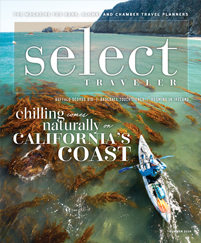When you visualize a trip, you recall the many postcard-worthy vistas. But sometimes, when you return home and upload your photos, they all look dark and too small to print in your newsletter.
Taking good photos can feel like the least of your concerns during a busy trip. However, pausing to frame a stunning photo of a group member looking out over the mountains can prove well worth the time. That same photo might help convince that group member or another potential traveler to join the next trip.
Learn to harness the power of photography for your next group tour by thoughtfully composing pictures that make viewers say, “I wish I was there.”
Composing the Shot
Rather than randomly aiming the camera at what’s happening during the trip, strive to capture intentional and appealing photos. For starters, most group leaders organize at least one group photo during the tour.
Though it might be easier to orchestrate a group photo while everyone is together during a mealtime or on the motorcoach, avoid making an indoor shot your one group picture. Instead, look for a backdrop that represents the area. For example, on a trip to Peru, pose the group in front of Machu Picchu.
If you are unfamiliar with the best group photo opportunity, ask the tour operator for some ideas. Once you have your plan, inform the group when and where you would like to take the photo, so you aren’t chasing after them during the tour.
But don’t limit yourself to one perfect group photo. Try to take diverse types of photos during the tour for a dynamic representation of the entire trip.
Look for some landscape shots with interesting elements in the foreground to provide a three-dimensional look. Also keep an eye out for opportunities to take photos of group members enjoying the trip.
Photography 101
Striving to reach National Geographic photography standards might prove more of a time commitment then necessary, since it is easier than ever for amateurs to take quality photos. First, cameras with high resolutions are cheaper than they used to be, and many smartphones can capture print-worthy shots.
Determine the resolution of your camera. The higher the resolution, the better. As a rule, resolutions over 1,000 pixels work well online and in print. For example, a 20-inch print would require a resolution of at least 1,600 by 1,200 pixels.
A more expensive SLR camera allows you to customize your shot with high-caliber lenses and manual settings, but if you don’t have a lot of technical knowledge, a simple point-and-shoot camera can take quality photos using an automatic setting. Just keep in mind three basic things when taking photos: stability, light and the rule of thirds.
A shaking camera will ruin the best photos, so try to keep your hands as still as possible. Buy a camera with an image stabilizer or a lightweight travel tripod. For light, photographers love the tones during the hour before and after sunrise and sunset. The middle of the day can produce dark shadows and harsh lighting, and should be avoided whenever possible.
Unless you purchase a high-tech flash, avoid using the flash whenever possible. Most photos taken with a basic flash cast ugly shadows, so it’s better to choose the automatic setting to disable the flash, which is the symbol of a zigzag arrow with a line through it. This ensures that your flash won’t automatically turn on when the camera detects darkness.
The rule of thirds breaks images into thirds, both horizontally and vertically, and places the photo subject along the right or left side of the image rather than in the center. This creates an image that is pleasing to the eye. An easy way to keep this in mind is to turn on your camera’s grid feature, which displays the grid of thirds on your screen.
Photography Promotion
After you take photos, don’t leave them in your camera; send them out as printed photos or in memory books to help sell future trips. Loyalty group travel programs rely on the bond created on the road, which encourages members to continue traveling with them rather than someone else. Danielle Young and many other group leaders foster this bond with their photography.
“We always take a group photo with an Oberlin banner,” said Young, executive director of the Oberlin College Alumni Association. “We try to make sure our trips feel like Oberlin trips. We print out the group photo and send it out after the trip.”
Even if you didn’t have time to take the photos, call upon the talents of your travelers to gather gorgeous travel photos to share with the group in an online photo-sharing site like Dropbox. Many group leaders will send a link to everyone’s email so that all members can see and add to the photo database.
With members’ permission, tag travel photos of members on social media so friends and family can follow along on the trip. Who knows? That tagged photo in front of the Taj Mahal may encourage a new traveler to sign up for one of your future trips.









